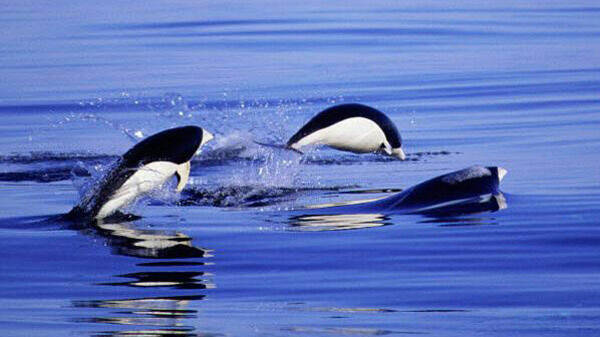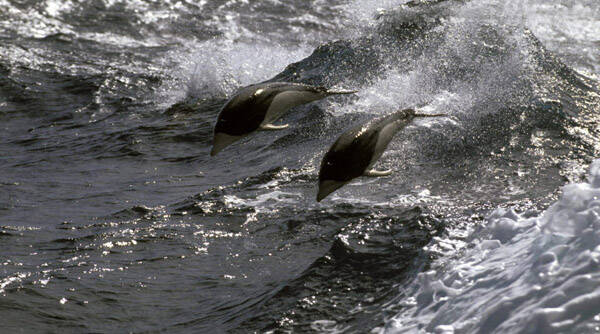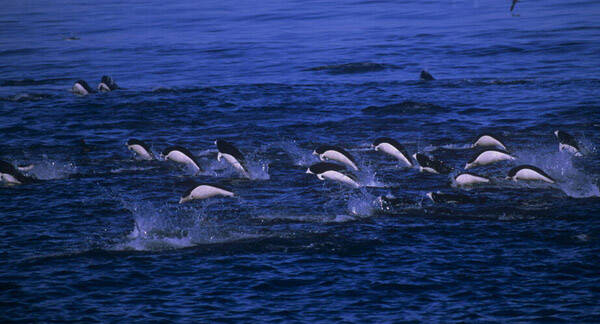Lissodelphis peronii
IUCN
LCBasic Information
Scientific classification
- name:Lissodelphis peronii
- Scientific Name:Southern whale dolphin, beaked dolphin without dorsal fin
- Outline:Cetacea
- Family:Delphinidae R.dolphin
Vital signs
- length:2-3m
- Weight:59-100kg
- lifetime:About 40 years
Feature
The only dolphin in the Southern Hemisphere without a dorsal fin
Distribution and Habitat
Origin (sea area): Argentina, Australia, Bouvet Island, Brazil, Chile, Falkland Islands (Malvinas), French Southern Territories, Mozambique, Namibia, New Zealand, Peru, St. Helena, Ascension Island, Tristan da Cunha, South Africa, South Georgia and South Sandwich Islands, Uruguay.
It is only distributed in the temperate to subantarctic waters of the Southern Hemisphere, roughly between 30° and 65° south latitude, and the Antarctic Convergence Zone is the edge of its southward activities; it extends northward along the west coast of the Southern Hemisphere continent, and the northernmost is the northern waters of Peru at 12° south latitude. It is an ocean-going species that lives in offshore deep waters. The suitable water temperature is 1~20℃. It occasionally appears in nearshore deep waters. It dives to 200 meters underwater when foraging.
Appearance
The beak is short and white, and there is a clear separation between the beak and the forehead. The forehead in front of the fumarole is white. The eyes are located in dark areas. The pectoral fins are small, curved and distinctively white (the pectoral fins may have dark leading and trailing edges); the pectoral fins are pointed at the ends. The jet black back may appear purple-brown on the sea surface; younger individuals may be gray. The boundaries between black and white areas on the body are clear. The abdomen is white; in younger individuals it may be milky white. Caudal peduncle narrow. The ventral surface of the caudal fin is white, and the color of the back gradually changes from light gray or white to dark gray or black. The trailing edge of the caudal fin is concave inward, with an obvious central notch. The slightly flatter body may have aided in stabilization, replacing the function of the dorsal fin.
Teeth pattern: 44/47 or 37-46/40-47, the lower jaw has slightly more
Details
The Southern Right Dolphin (scientific name: Lissodelphis peronii) is also known as the Southern Right Whale Dolphin. It has no subspecies. It is the only dolphin in the Southern Hemisphere without a dorsal fin, and has a distinct black and white pattern on its body. If the Southern Right Dolphin is in a distant sea or swimming fast, it may be mistaken for a penguin; when it swims slowly, it may be mistaken for a fur seal or a sea lion. The Southern Right Dolphin is named after the Southern Right Whale, which is larger and has no dorsal fin.

Southern right dolphins are graceful, often making a series of long, low-angle leaps in rapid succession: the overall movement gives the impression of a penguin swimming at high speed. Sometimes they swim slowly, with almost no waves; when they rise to breathe, only part of their head and dark dorsal fin are exposed above the sea. Capable of leaping (but not twisting or turning in midair), belly-striking, side-striking, and tail-striking. Dives can last up to 6 minutes or longer. Some groups will allow boats to approach, others will avoid them. Bow-riding is common when swimming with other cetaceans, but rarely occurs otherwise. Often seen swimming with dusky dolphins, hourglass dolphins, or pilot whales.
Southern right dolphins are highly social, with the average group size being 210, but groups of 1,000 can occur. When in a slow-swimming group, they only bring their heads and blowholes above the water to breathe. In fast-swimming groups, members can choose two different strategies: the first is to swim fast just below the water surface, quickly surface to breathe, and then return to the surface; the other is also to swim fast on the surface, but to make small-angle jumps, splashing a series of waves.

Southern right dolphins are fast swimmers, but there are few speed records in the open ocean. The diving cycle is 10 to 75 seconds, and the diving of groups can reach 6.5 minutes. It mainly feeds on mid-ocean fish at 200 to 1,000 meters underwater, including lantern fish, bigeye tuna and squid. There are no records of natural enemies, and the threat of predation may come from killer whales and sleeper sharks.
There is a lack of information on the mating and reproduction of southern right dolphins. It is speculated that males reach sexual maturity when their body length is 212 to 220 cm and females reach 206 to 212 cm. The lifespan of the closely related northern right dolphin in the wild is 42 years, and the southern right dolphin may be similar. The southern right dolphin in captivity has a short lifespan, with an average survival period of only 3 weeks, and the longest-lived one lived to 15 months. Southern right dolphins may hybridize with dusky dolphins (Yazdi, 2002).

There are no accurate population counts of southern right dolphins, nor is there any knowledge of their subpopulation composition. In the waters north of Chile, preliminary marine surveys and fishery records of strandings suggest that they may be the most common cetacean species in the area (Jefferson et al. 1994, Van Waerebeek et al. 1991). A survey by Akeya et al. (1998) found that the southern right dolphin was the most common species between Valparaiso and 76°W. The southern right dolphin is used as human food and crab bait in Peru and Chile (Jefferson et al. 1994). No mortality estimates have been made.
Listed in Appendix II of the Convention on International Trade in Endangered Species of Wild Fauna and Flora (CITES).
Listed in China's "List of National Key Protected Wildlife": National Class II Protected Animal (effective December 10, 1988, Cetacean*Other Cetaceans).
Listed in the IUCN Red List of Threatened Species: Data Deficient (DD), 2008 assessment.
Protect wildlife and eliminate game.
Maintaining ecological balance is everyone's responsibility!








